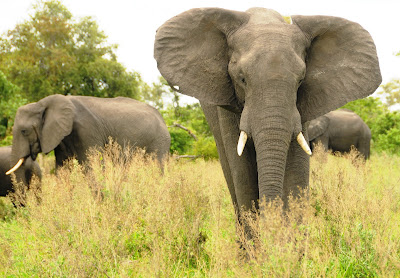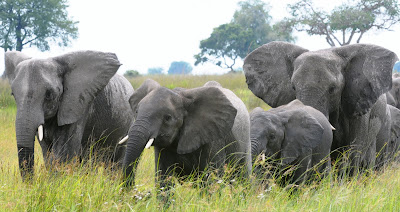
December 7 2009
Lions were roaring intermittently throughout the night at Kwara, and this morning they were found not too far away. Lions + hippo + assorted other night sounds = not too much sleep. Thank goodness for the siesta time! Kathleen and went across to Little Kwara on an inspection visit and found it to be a perfectly delightful spot. Little Kwara is an intimate camp sleeping only 10 persons in 5 elevated rooms. The rooms are very large with massive bathrooms, his and hers wash basins, a great verandah facing out over the floodplain, a fan and bath and double outside showers. All in all a very impressive camp, enhanced by an excellent common area with a nicely integrated dining room, lounge, bar and adjacent pool.

A room at Little Kwara

Part of the bathroom at Little Kwara

Part of the dining room at Little Kwara

Deck and pool at Little Kwara

Little Kwara Lounge
At 1145 on the dot, we said our reluctant goodbyes at Kwara, to the sound and song and dance of several of the staff members, whom we had genuinely come to like and respect. Off we went on a 35 minute flight in a Caravan to Lebala Camp in the Kwando Concession. The camp was just a short ride from the airstrip, and once again we arrived in the midst of a thunderstorm. We were promptly shown to room 4 which was very similar to the rooms at Little Kwara. Quite luxurious with a large double bed & lounge area with two comfortable chairs. The room also sported a side table, a large vanity doubling as a desk with chair, and a huge big bathroom with separate toilet, foot and claw bath, and double outside showers. My only complaint? We could hear everything that was going on in the tent next to us.

A sendoff from the wonderful staff at Kwara

They sent us on our way with some spirited singing and dancing

Nicely decorated double bed at Lebala

Portion of the bedroom

Partial view of the bathroom at Lebala
That afternoon, we took off with our guide Spencer on an uneventful drive with good birding including 2 painted snipes, and several other species new to the trip list. We also enjoyed some good sightings of elephant, kudu, zebra and other general game. All in all, Lebala gets high marks for the rooms but the food was not quite up to the high standard set at Kwara. Perhaps it is best to be an omnivore and not a vegetarian at this camp. For someone who does not eat eggs, meat or cheese, brunch in particular was very disappointing, basically toast with baked beans, some mushrooms and fried tomato, every day. Fortunately there is also a selection of cereals including a pretty good muesli. Somehow none of the
December 9
I randomly picked this day for a ‘minute by minute’ account of a typical game drive in
We started off from Lebala Camp right at 0600. It was a cloudless morning, cool until about 0900A and then a scorcher until about 1500 when a large thunderstorm rolled through the area. In the vehicle were our guide Spencer, our tracker P.D., Kathleen and myself and two Danish guests Paul and Kirsten.
00:1:00 A juvenile kudu chewing on a wild cucumber, rolling it in its mouth, the white ‘lip gloss’ and white chin clearly visible. What massive ears! We spent several minutes with the kudus (several more emerged from the bush).
00:5:43: A Blackshouldered Kite.
00:8:00: Six Egyptian Geese at a water hole; we witness a very intense squabble between two males, with lots of wing-flapping and chest-bumping, and even more noise. Soon enough one of them gave way and the victor strutted around for a bit to show everyone who’s the boss.
00:28:41: An impressive Kori Bustard, the world’s largest flying bird.
00:41:15: A juvenile Bateleur Eagle impersonating an owl, turning its head 360 degrees to look back at us.



01:30: We make a comfort stop, aka a bush break, pit stop, or checking the tires.













December 10
This morning we set off in the direction of Lagoon Camp, the purpose being to combine a road transfer (two Danish guests from Lebala to Lagoon) with a game drive. The morning started slowly but it wasn’t too long before we ran into several very nice herds of elephants. While looking for wild dogs, we first noticed some Yellowbilled Kites flying over one particular spot and then some vultures. And before we actually saw it, the smell hit us. “IT” was a dead elephant (apparently of natural causes) which was being fought over by two competing packs of hyena. There were probably 10 to 12 hyenas around, some with clearly distended bellies, having successfully gorged themselves on this bonanza. Later on one of the other cars would actually witness some sparring between the two competing clans. Thankfully we did not stick around too long: there are few things as pitiful and sad and upsetting a sight as a massively swollen dead elephant lying unceremoniously splayed out, several days dead. In the afternoon, we unsuccessfully tracked a leopard, following its tracks around and sometimes over a variety of trees, bushes and shrubs, from mopane to Kalahari apple leaf, Apparently we got very close, as the last sighting, just before we lost the light in the late afternoon, was where the leopard had spent quite a bit of time resting up. The tracks were very fresh. By then we were pretty beaten up from the jostling one takes especially in the back of the Uri game-viewing vehicle, so we were not entirely unhappy to let the leopard be and to stop for sundowners before making our way back to camp.

A breeding herd of elephant at Lebala


Yet another yellow-billed kite

This one - and a few others - were hawking emerging termites just outside camp one morning




And some zebra; we would see plenty more at Nxai Pan

Tracking leopard at Lebala

If you can't go around the pesky trees, go over them...

One of the hyenas hanging out near the dead elephant

Plenty more giraffe in the Lebala area


Like giraffe everywhere, they like to stare at people
December 11
The morning game drive was initially a bit frustrating, as we were again unable to locate the wild dogs, whose tracks were all over the southern area of the concession. Even so, we were consoled by the sighting of two of the largest breeding herds of elephants we had seen on the trip yet. The first herd we saw as they came to a waterhole and it was - as always – most entertaining and enlightening to see them drink. They take in as much as 10 liters or more at a time, and the sound is not dissimilar to having a large bucket of water poured down the throat.

Acting like giraffe (staring at people...)

Part of the breeding herd of elephants


One of a small group of roan antelope we saw at Lebala
 I took several photographs of various individuals belonging to the breeding herd which came to a water hole at Lebala
I took several photographs of various individuals belonging to the breeding herd which came to a water hole at Lebala





On the way back to camp, we were alerted by radio that Thabo, one of the other guides, had found wild dogs at a waterhole. Arriving on the scene about 15 minutes later, we realized that this was yet another different pack, which now made it four different wild dog sightings over the space of just 9 days. This time, we were lucky to find a group of 12 dogs, consisting of 6 adults and 6 pups, about 1 year in age. Just like puppies would, they made mock charges on each other, frolicked around and played tug of war with a dried branch. We stayed with them for a good 15 minutes or so, shooting off multiple exposures, before winding back to camp for brunch. By 1130A we were packed and ready for departure. A short trip to the airstrip was followed by a 35-minute flight to Maun where we disembarked from the aging (1972 vintage) Islander. Pilot Dale told me that the aircraft undergoes a minor servicing every 50 hours and a major service every 100 hours. So despite its shabby interior and the fact that it was sorely in need of a paint job, the critical components of this workhouse were in good shape. It got us safely to Maun and then on to the airstrip at Nxai Pan National Park, where we would spend the last 4 days of our Botswana trip.

One more group of wild dogs at Lebala







1 comment:
Once again WOW! Great shots. We loved Lebala, evidenced by the fact we went there the last 2 trips, Spencer was our first guide, and Thabo our guide in Sept. Like you we found the dogs... that was the highlight for me, as we never located them the last trip. The pack we found though was 11 adults and 8 pups... seems like they have split into 2 separate groups now. The other thing we enjoyed at Lebala was the elephants eating from the trees around our porch during the evenings when they moved through camp. We would slide our doors open and just watch as they took turns picking the berries off the trees. We saw 3 "visiting" male cheetahs there in September, wonder if it is the same 3 that have moved off towards Kwando camp? I agree about the food choices for vegans, Dan had a few problems there as well, but days 2-4 they made butternut squash dishes for him to try to compensate. Keep those pics coming they are terrific!
Post a Comment